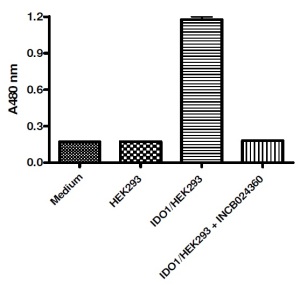Which roles do IDO and TDO play in Immunotherapy? Immune evasion is one of the identifying hallmarks of cancer and researchers are investigating the complex mechanisms that enable cancer cells to evade the host’s immune system. In the context of a tumor, Tryptophan (Trp or L-Trp) catabolizing enzymes have been shown to assist cancer cells in immune evasion.

Trp is an important and essential amino acid that has a variety of functions within the cell. In addition to being incorporated into the polypeptide chain of proteins, various catabolic pathways can produce a number of functional Trp derivatives.
Trp is the biosynthetic precursor of the co-factor NAD, a number of antibiotics, and the neurotransmitters serotonin and melatonin. The factors regulating the fate of Trp in the cell have yet to be fully elucidated, but likely involve specific enzymes that may vary in expression levels or with the cell type. (Fig. 1 – Shown is a depiction of two important tryptophan catabolic pathways and the enzymes that participate in the process).
Inhibitors of indoleamine 2,3-dioxygenases (IDO1 and IDO2) and/or tryptophan 2,3- dioxygenase (TDO) may exhibit off target effects on TPH enzymes. Additionally, inhibiting the IDO/TDO pathway may drive tryptophan catabolism via the TPH pathway).
Role of IDO and TDO in cancer
Cancer cells use IDO1 and IDO2 and TDO enzymes that catalyze the first and rate limiting step of the kynurenine (Kyn) Trp degradation pathway (Fig. 1), to suppress the host’s immune response in order to facilitate survival, growth, invasion, and metastasis of malignant cells (Fig. 2).

Figure 2 shows (A) PD-1 inhibitors have shown clinical efficacy, but many tumors upregulate expression of IDO1 and/or TDO, resulting in Trp depletion in the tumor microenvironment and increased levels of the Trp metabolite, Kynunerinine (Kyn) which combine to induce T cell cycle arrest and apoptosis. Also demonstrated is (B) inhibition of IDO1 and TDO has the potential to halt T cell inhibition caused by Trp catabolism (provided by BPS Bioscience)
IDO1 and TDO (also known as TDO2) are overexpressed and/or overactive in many tumors, resulting in Trp catabolism, Trp starvation, and cell cycle arrest and death of effector T cells within the tumor microenvironment. This immunotolerant environment allows cancer cells to avoid immune cell targeting (Fig. 2). Less is known about other Trp-degrading enzymes, like tryptophan 5-hydroxylase (TPH) 1 and 2, which also appear to regulate anti-tumor immunity. Recently, substantial research efforts have focused on the identification and development of inhibitors of the various Trp catabolic enzymes.
Cell-based assays to assess IDO1 and TDO

BPS Bioscience offers a wide variety of unique tools to identify both broad and selective inhibitors to these critical pathways.
The human IDO-1 Cell Based Assay Kit and TDO Cell-Based Assay Kit are designed to monitor the activity of exogenously expressed human IDO1 or TDO in cultured cells.
The kits contain a “transfection-ready” expression vector for full length human IDO1 (hIDO1) or TDO (hTDO), respectively. Upon expression, hIDO1 or hTDO can catalyze L-Trp conversion to Kyn, which gets released and is easily detected in the assay medium. The kits also include specialized assay media and all components necessary to fully activate hIDO1 or hTDO (for results with the IDO-1 kit, see Fig. 3.)
Furthermore, you can also make use of stable cell lines over expressing either IDO-1 or TDO.
Biochemical assays to screen for IDO-1, IDO-2 and TDO inhibitors
Besides cell based assays biochemical assays are needed in screening campaigns. IDO-1, IDO-2, and TDO kits are either based on colorimetric or on fluorigenic read-out methods and allow to screen for inhibitors. For typical results with the TDO kit see Fig. 4

Interested in these tools to measure IDO and TDO activities or to screen for inhibitors of there emerging targets in Drug Discovery? Contact me with your requests or comments below.



